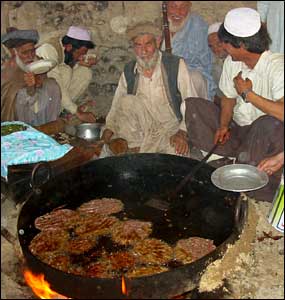here are religious and social festivals celebrated by the people of Balochistan. Two major religious festivals are Eid-ul-Azha and Eid-ul-Fiter. On these festivals people adorn their houses, wear new dresses, cook special dishes and visit each other. Eid-Meladun-Nabi
is another religious festival. It is a celebration of the Holy
Prophet’s birthday. Numerous colorful social festivals are also source
of jubilation. Sibi festival that traces its roots to Mehergar,
an archeological site of ancient human civilization, attracts people
from across the country. It is attended by common folks, ministers and
other government officials. Folk music performance, cultural dances,
handicrafts stalls, cattle shows and a number of other amusing
activities present a perfect riot of color. Buzkashi is a peculiar festival showing valour of Balochistan people. It is celebrated on horse-back by two teams that use their skills to snatch a goat from the each other.
This Blog Explore Pakistani Lifestyle, Culture, Heritage, Traditions and Enlightens Hidden Beauty of Pakistan.
Thursday, August 29, 2013
Balochi Dresses
The mode of dress among the Balochi, Pashtoon and Brahvi tribes is very similar having a few minor dissimilarities. Turban is the common headwear of the men. Wide loose shalwar
(a bit similar to loose trouser) and knee-long shirts are worn by all.
The dress of the woman consists of the typical shirt having a big pocket
in front. The shirt normally has embroidery work with embedded small
round mirror pieces. Big ‘Dopatta’ or ‘Chaddar’, a long rectangular piece of cloth cascading down the shoulders and used to cover head, are used by the women.
Balochistan Province Culture
Balochistani culture is primarily tribal, deeply patriarchal and conservative. Baloch society is dominated by tribal chieftains called Mirs, Sardars and Nawabs, who are the ruling elite of Balochistan and have been criticized for blocking the educational development and empowerment of the common baloch people.
Province Balochistan, Pakistan
Balochistan ( Brahui: Balocistán)
is the largest province (by area) of Pakistan, constituting
approximately 44% of the total land mass of Pakistan. According to the
1998 census, Balochistan had a population of roughly 6.6 million.
Its neighboring regions are Iran to the west; Afghanistan and Khyber Pakhtunkhwa to the north; and Punjab and Sindh to the east. To the south lies the Arabian Sea. The main languages in the province are Balochi, Brahui, Pashto, Sindhi and Urdu. The provincial capital is Quetta and Gwadar is the developing port city .Balochistan is rich in mineral resources; it is the second major supplier of natural gas in Pakistan.
Its neighboring regions are Iran to the west; Afghanistan and Khyber Pakhtunkhwa to the north; and Punjab and Sindh to the east. To the south lies the Arabian Sea. The main languages in the province are Balochi, Brahui, Pashto, Sindhi and Urdu. The provincial capital is Quetta and Gwadar is the developing port city .Balochistan is rich in mineral resources; it is the second major supplier of natural gas in Pakistan.
Pashtun Dresses KPK
Pashtun Culture
Pashtun culture is based on Pashtunwali, which is an ancient way of life, as well as speaking of the Pashto language and wearing Pashtun dress. The culture of the Pashtun people is highlighted since at least the time of Herodotus
(484-425 BC) or Alexander the Great, when he explored the Afghanistan
and Pakistan region in 330 BC. Over the different periods in history,
the Pashtun culture has been influenced by the people of South and Western Asia to a certain degree. For example, just like with most other cultures in the area, it has been fully Islamised by Arabs during the Caliphate period.
Province Khyber Pakhtunkhwa, Pakistan
Khyber Pakhtunkhwa
Khyber Pakhtunkhwa , locally Pukhtunkhwa,
previously known as the North-West Frontier Province and various other
names, is one of the five provinces of Pakistan, located in the
north-west of the country. It borders Afghanistan to the north-west, Gilgit-Baltistan to the north-east, Pakistan administered Kashmir to the east, the Federally Administered Tribal Areas (FATA) to the west and south and Punjab and the Islamabad Capital Territory to the south-east.
The main ethnic group in the province is the Pashtuns; other smaller ethnic groups include most notably the Hazarewals and Chitralis. The principal languages are Pashto, locally referred to as Pukhto.
The main ethnic group in the province is the Pashtuns; other smaller ethnic groups include most notably the Hazarewals and Chitralis. The principal languages are Pashto, locally referred to as Pukhto.
Subscribe to:
Comments (Atom)




































